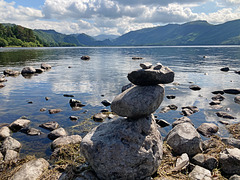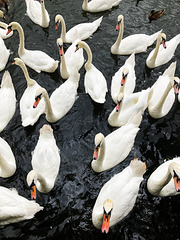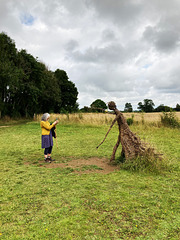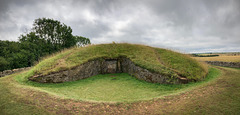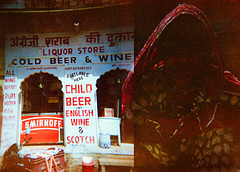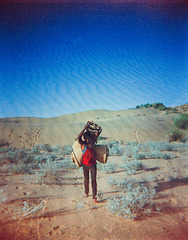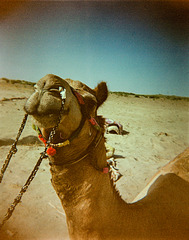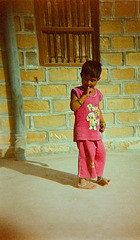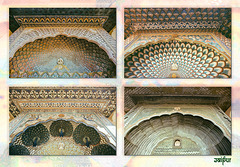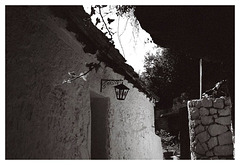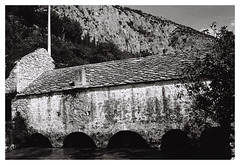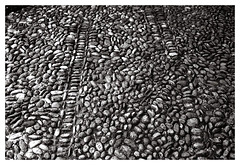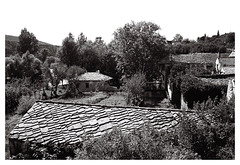m̌ ḫ's photos
Scene from the Calfclose Bay
| |
|
|
|
Calfclose Bay is part of four waymarked walks starting from the Keswick Foreshore. The circular Lakeside Amble visits the Centenary Stone sculpture, and offers a great place for a picnic in summer, with undisturbed views across Derwentwater onto Catbells and down to the ‘Jaws of Borrowdale’.
Little duckling and its adult role-models
| |
|
|
|
There are many swans in Windsor. Swan Upping is an annual census of this bird's population of the River Thames. The ceremony takes place during the third week of July every year. The historic ceremony dates back to the 12th C a.d. when the Crown claimed ownership of all the mute swans. Today the Crown retains the right of ownership of all unmarked mute swans on certain stretches of the River Thames and its surrounding tributaries. While rowing by Windsor Castle, it’s tradition for the Uppers to toast to “Her Majesty the Queen, Seigneur of the Swans.” The Queen isn’t usually home to appreciate the gesture—she’s only attended one Swan Upping throughout her entire reign.
A Witch is taking you...
| |
|
|
|
Banbury-based environmental sculptor David Gosling made a witch sculpture at the Rollright Stones - reflecting the folklore legends associated with the Stones.
Belas Knap Long Barrow
| |
|
|
|
Belas Knap is a particularly fine example of a Neolithic long barrow, with a false entrance and side chambers. Excavated in 1863 and 1865, the remains of 31 people were found in the chambers.
It was probably constructed around 3000 BC and was used for successive burials over a period of years until eventually the burial chambers were deliberately blocked.
Although Belas Knap seems in good condition, this is the result of several restorations.
Romano-British pottery found inside one of the burial chambers show that it was open in Roman times. It was explored between 1863 and 1865 using the archaeological methods of the time, and some years later was restored by Mrs Emma Dent of Sudeley.
In 1928–30 the site was excavated again, before being restored as we see it today.
www.english-heritage.org.uk/visit/places/belas-knap-long-barrow
English wine shop
| |
|
|
|
A hut only... really?
| |
|
|
|
Interestingly, using these old techniques, the houses even without air conditioning are more comfortable than the modern houses in Indian cities. In summer, such house has a temperature inside 10 degreees lower comparing to the outside. Nice example how the development in the modern architecture actually led us to a lower standard of living, which is needed to overcome by spending energy and further harming the environment.
Let's build the base, cook, and sleep
| |
|
|
|
Preparing forour night under the sky in the Rajasthani Thar desert. These men made us a fantastic and spicy dinner, and told us a quite absurd story of a Japanese tourist they've been guiding before. This unexperienced traveller went astray in desert while taking photos of a starry night, and he slept on a tree. On the contrary, our night was fantastic, under an open sky with a full moon shining.
Let's find a place to sleep in a desert
| |
|
|
Sleeping in the Thar desert is an attraction provided in Jaisalmer.They take you at the dessert to see the sunset and then you can sleep on a large matrace right under the stars. I skipped any camel driving due to previous bad experience. The best is to stay on your own legs
Friendly or not?
| |
|
|
|
I think, that...
Four Doors in Jaipur
| |
|
|
|
The City Palace in Jaipur is an exquisite maharaja’s palace. I wandered around the complex amazed that each section seemed even more impressive than the last. Built in the 18th Century for the Maharaja of Jaipur, the palace is still a royal residence today.
In an inner courtyard called Pritam Niwas Chowk, there are four doorways in the walls. Each of these doors is unique in its design and decoration, and beautiful to behold. The four doors represent the seasons and different Hindu gods.
The Rose Gate (representing winter) is dedicated to the goddess Devi.
The Green Gate (representing spring) is dedicated to Lord Ganesha.
The Lotus Gate (representing summer) is dedicated to Shiva and Parvati.
The Peacock gate (representing autumn) is dedicated to Lord Vishnu.
In the silent streets of a traditional village
| |
|
|
|
Blagaj tekke
| |
|
|
|
The Tekke (khanqah, dervish house), set at the source of the river Buna, was and still is a venue for dervish Zikr praise-chanting three nights weekly. Built at the site of an earlier Bogomil sanctuary, it is a place of which history has no precise and stored data.
Archeological excavations have found and confirmed that this location holds the remains of a Late Antique structure. During the Middle Ages, even before the arrival of the Ottomans, it was a place of utter cultural and religious importance (1454). The first written track of the Tekke was made by Evlija Celebija in 1664. in his travelogues, at time when the Tekke was already well-known throughout the Ottoman empire and within the scientific community.
Throughout its history the housing complex next to the Tekija was rebuilt and redecored on multiple occasions. The Tekija was actively open until its last shaykh Sejdo Sehovic died in 1925.
After the Second World War, activities of the dervishes and the Tekke in Bosnia and Herzegovina were officially banned. Until early 70s, the Tekija was managed by the National Museum of B&H. Since then until 1974. it was officially without a trustee, after which time the Islamic Community, with no previous government consent, started using and protecting it from further delapidation. By reviving the tradition of the pilgrimage site, the common annual Mawlid (religious celebration of the birth of prophet Mohammad S.a.v.s.), the Tekke started reestablishing its previous importance. The last reconstruction of the Tekke was done in 2013. and a year later, in 2012. the completely destroyed housing complex – musafirhana (guest house) at its entrance were reconstructed as well.
River, stone, mountain, sky
| |
|
|
|
The mills by the Tekke. Very close to the source of the river Buna, channels branch off leading water to power the mills. Several mills, stamping mills and two fulling mills were built. There was one mill on each bank of the river. Part of the mill on the right bank of the river has been converted into a souvenir shop; all that remains of the rest of the mill is the stone walls. As a rule mill buildings are simple stone-built structures with gabled roofs clad with stone slabs, and with one or more mills.
whc.unesco.org/en/tentativelists/5280
Over there I'd like to have a sleeping room
| |
|
|
Game of pebbles
| |
|
|
|
Alone in the shadow
| |
|
|
Lovely patterns of stone roofs
| |
|
|

